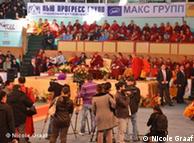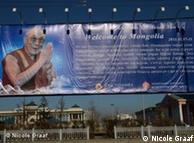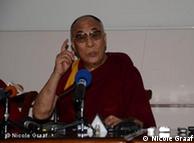達賴喇嘛本周訪問蒙古共和國,這也是他1979年以來第8次到訪該國。大約一半的蒙古居民都是藏傳佛教的信徒,達賴喇嘛在烏蘭巴托進行了三天的講經佈道,而大學生則是他啟迪教育的重點對象。
在烏蘭巴托甘丹寺的廟堂裡,擠滿了虔誠的信徒。雖然溫度已經是零下,但這絲毫沒有阻擋人們的熱情,大家都耐心的等待著。
週一晚間到訪蒙古的藏傳佛教精神領袖達賴喇嘛在首都烏蘭巴托舉行了三天的佛經講學。每天上午,他給蒙古大學生作演講,台下座無虛席。
達賴喇嘛談到佛教經典和現代科學之間的共同之處,並鼓勵年輕蒙古人遵循自己的傳統,重新回歸佛教理念。
現代的教育主要集中在膚淺的東西上,但是並不能帶來內心的和平。你們在蒙古已經掌握瞭如何找到內心平靜的方法,只是你們不用它。這多可惜啊!假如你們把佛教和現代教育結合起來,就可以建造一個更加幸福的社會。
講經現場講經現場
不只是大學生,許多年長的信徒也專程趕來一睹達賴喇嘛的風采。 70歲的老人吉格吉德沒能進到會場裡面,只好和許多其他人在外面等,盼望著至少能在達賴喇嘛出來的時候看上一眼。他對記者說:
"我有一個非常虔誠的家庭。從我的祖父到我的兄長,他們全都是喇嘛。因此我也很想過來,看看達賴喇嘛。我小時候,信仰宗教是被禁止的,但是現在又自由了。我認為,人們互相尊重、互相同情是很重要的。現在,我每天早上都會轉一轉轉經輪,點亮酥油燈,然後在離家出門之前再禱告一番。"
從1924年到1991年,蒙古一直實行共產主義統治,並與蘇聯保持著密切的聯繫。官方禁止一切宗教活動。當時,人們只有偷偷地在家裡進行佛教儀式。成千上萬名喇嘛在30年代遭到迫害。現在,佛教重新在蒙古興盛起來,自從90年代民主化之後,大批的僧侶遠赴印度的大型藏傳佛教寺廟進修學習。
達賴喇嘛著重教育年輕人回歸傳統
不過,現在年輕的一代蒙古人當中,傳統的信仰已經部分流失。因此達賴喇嘛也將年輕的蒙古人列為自己此次佈道講學的主要對象。
我這一代人要漸漸地淡出了。但你們年輕的一代,生活才剛剛開始。蒙古的未來完全掌握在你們手中。
達賴喇嘛的演講給21歲的奧德格雷爾留下了深刻的印象:
"我認為他講的很重要。即使你心情鬱悶,不管你在什麼情況下,都應該保持精神的放鬆和平靜。"
達賴喇嘛來訪:棘手事宜
達賴喇嘛此次蒙古之行僅僅提前一天公佈,據猜測這與中國政府方面的抗議有關。也許蒙古方面想來個出其不意,以既成事實說話。向達賴喇嘛發出邀請的甘丹寺的新聞發言人達瓦普雷夫用外交辭令解釋了為什麼這麼晚才公佈行程的原因:
"這應該和政治上的問題有關聯。對蒙古的佛教徒來說,達賴喇嘛能經常來做客是一件好事,但政治上的問題是難以避免的。當然了,他的出訪不帶有任何政治背景,而是單純的宗教活動。"
達賴喇嘛,歡迎你達賴喇嘛,歡迎你
儘管如此,中國政府還是對這一訪問提出了抗議,指責達賴喇嘛借出訪之機從事分裂國家的活動。達賴喇嘛一向對此類指責予以反駁。不過,對於蒙古國來說,達賴喇嘛的訪問的確是一件棘手的事情。該國在經濟上對中國有很強的依賴性,它對外出口產品的三分之二都是流向中國。而人們在蒙古境內能夠買到的商品,不是中國生產的,就是途經中國進入市場的。
此前,蒙古政府曾試圖將達賴喇嘛此行每天下午的講經活動地點轉移到另一個場所去。因為中方抗議,原定的講經地點--位於烏蘭巴托機場附近的新體育場是中國援建的。不過,最終蒙古政府還是無法抵擋民眾的壓力,決定活動按原定計劃舉行。
作者:李小紅
責編:洪沙
 讲经现场
讲经现场 达赖喇嘛,欢迎你
达赖喇嘛,欢迎你China’s restive Tibetan regions
No mercy
Self-immolations continue, as do the Communist Party’s hardline policies
Nov 12th 2011 | SONGPAN | from the print edition

Over three years ago Tibet and Tibetan-inhabited parts of Sichuan, Qinghai, Gansu and Yunnan were engulfed by the biggest wave of anti-Chinese unrest in decades. Today it is in Sichuan’s highlands that the authorities appear to be struggling most to contain simmering discontent among ethnic Tibetans. Sichuan’s two “autonomous prefectures” with large Tibetan populations are Aba (Ngawa in Tibetan) and Ganzi (Kardze), whose combined area is almost the size of Great Britain. Much of the area was once part of the famously warlike traditional Tibetan region of Kham. In 1991, China’s then Communist Party chief, Jiang Zemin, said that “to keep Tibet stable, it is first necessary to pacify Kham”. That attitude is an ancient one among China’s rulers, and still applies.

The authorities have been trying to keep foreign journalists out of the worst-affected areas of Aba and Ganzi. They are nervous that news of the immolations and the grievances that led to them will inflame tensions among more than 1m Tibetans in the two prefectures. (The population in Tibet proper is three times larger.) The handful of journalists who have ventured beyond Songpan this year have been briskly caught and turned back. The police have recently been helped by snowfall on the mountain road from Songpan to Aba town, which is at around 3,200 metres (10,500 feet) above sea level.
Officials have reason to be fearful. For Tibetans, self-immolation is a new form of protest. Such acts are difficult for the authorities to prevent, and images of them can have a powerful psychological effect among sympathisers. Eleven Tibetans have tried to kill themselves this way since March. Six have succeeded, the latest a 35-year-old nun in Ganzi on November 3rd.
On October 19th Tibet’s exiled spiritual leader, the Dalai Lama, held a prayer ceremony for the dead in Dharamsala, the Indian town where he now lives in exile. China’s foreign ministry accused him of inciting “terrorism in disguise”. Fire extinguishers have become the accoutrement of choice for police patrols (see picture) as far away as Lhasa, the Tibetan capital some 1,200km south-west of Songpan.
The anger and desperation that has prompted Tibetans to set fire to themselves is common across the plateau. In all of China’s Tibetan-inhabited areas, the authorities have rounded up innumerable monks, nuns and laypeople for taking part in the 2008 unrest. Reports of torture are rife. Many monks have been forced to denounce the Dalai Lama, who even in Songpan, where things are relatively calm, is deeply revered by Tibetans. This correspondent was often asked for news of him. “You can’t call yourself a monk unless you support the Dalai Lama”, says a Songpan resident.
But Aba and Ganzi share an additional layer of resentment. Both prefectures saw the only well-documented cases of police firing on demonstrators in 2008 (20-30 people may have been shot dead in Aba town). Unlike Songpan county, where monasteries are small and scattered, Aba’s main monastery, called Kirti, is large and central. Monks at Kirti have been particularly prominent in the prefecture’s unrest, and the monastery is now under heavy police guard.
Woeser, a Tibetan blogger in Beijing who closely monitors the region, says the authorities inadvertently exacerbated Sichuan’s instability by expelling hundreds of visiting monks from monasteries around Lhasa after the 2008 unrest. Many of these monks were from Sichuan, and they returned to their monasteries with tales of Lhasa’s upheaval and the recriminations that followed. Others, barred from their original monasteries, became wandering malcontents. In Ganzi, Woeser says, passions have been stoked by the hardline fulminations of the prefecture’s ethnic-Han party chief, Liu Daoping. (Aba has a Han party secretary too, as, invariably, does Tibet itself.)
The authorities have tried to intimidate Sichuan’s Tibetans into giving up their protests by imposing heavy sentences on monks accused of involvement in the immolations. Free Tibet, a London-based NGO, says six have been jailed so far. Whose side the judiciary is on is clear from the title bestowed on Songpan’s county court: “Advanced Collective Engaged in the Task of Opposing Separatism and Preserving Stability”. Not much subtlety or accommodation there. Sichuan’s restive monks can expect no mercy.

沒有留言:
張貼留言